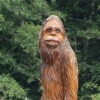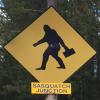I see in my last post that the second figure didn't come out the same size as the rest. Oh well, the radii are still stated there for comparison.
Tooth Impression Possibilities
Our interpretation from analysis of the evidence is that we are seeing at least two adults, possibly three, because there is not enough evidence on the first bone pile to identify a third individual, and one juvenile. Something I noticed about these juvenile impressions is that they show bumps on the edge. You can see this in the pictures of the smaller impressions in a couple places on the ribs of EK#1. This is what I found out about human teeth: "New anterior adult teeth almost always have bumps on their incisal (biting) edge, known as mamelons."
http://www.ecds.on.ca/ask_dentist/teeth_bumps.html
Very, very, interesting!
The larger impression range on all the bones is .42 to .75 inches.
The smaller is .21 to .40 inches.
The average adult human range for incisors from our research is .22 to .44 inches. So the smaller impressions are very close to adult human size teeth. The larger impressions are bigger than human.
Looking at what we have for measurements we can now go through a process of elimination of known animals.
These impressions were visibly made by at least three flat incisors. In carnivores, the largest canines on a grizzly bear are about 5/8" in diameter. Canines produce large round or oval punctures, or they just split the bone. But they do not chisel it as seen with these tooth impressions. Compare the images of the smaller scavenger teeth marks and imagine this damage enlarged. The incisors of the largest carnivore in NA, are only 1/4" to 5/16" wide. These incisors positioned as they are between the canines will usually register as crenulations (small bumps) in the flesh along the bone as it is consumed or, at most, small chips on the edge of the bone. (If you zoom in on the edge of the bones of our control specimen, which I have yet to post, you might be able to see these crenulations.) The only way we can get a good impression from a carnivore incisor is if it put the bone in its mouth and bit across the bone between the canines,which we don't see here. Carnivore carnasials (molars) are used to break bone and they leave deep pits and fractures in the bone; this is usually across the bone. (Watch Bigtex's wolf chew the bones. She is using her carnasials.) Carnivores are the most likely suspects but are actually the easiest to rule out.
Other possibilities: rabbits and/or rodents (beavers, porcupines, etc.). They gnaw on things constantly to wear their teeth down because the teeth never stop growing. They also gnaw bones for calcium and other things for salt. The biggest problem here is that their teeth are in pairs; top and bottom jaws. They also create scores in whatever they are gnawing on. Some everyday examples are: beaver chewed sticks, porcupine chewed trees, rodent gnawed bone and antlers. If you spend enough time in the field you can recognize this gnawing and it is nothing like what we are seeing on these bones. Most of the double scores you see from these animals are less than a quarter inch wide individually. Another thing is that considering the size of these animals, something else would have made the initial kill and disarticulated the bones for them to later find and gnaw on. If it was a cougar kill, they are very protective of their kills. I have found a dead and eaten skunk next to a cougar killed deer before. These kills were fresh (a couple months at most). Our control specimen was six months old the last time visited with still no rodent gnawing present. And the bones were just starting to disarticulate due to natural decomposition.
Horses and other ungulates. Most don't even have upper incisors! Only horses have teeth that could possibly match what we have found. Now if it was fruit I would say it was a good possibility. But I haven't heard of any meat eating horses (I could be wrong though). Pigs might be another possibility but there aren't any in the area. Besides, their teeth aren't lined up nice and neat like we see here.
When we first started our research, my research partner contacted a WA state biologist. All he had was a description of what we had found; no pictures and no measurements. He said it was most likely human behavior. As I said, he didn't have all the facts. Okay, how many of you have such big teeth and go out into the woods, rip carcasses apart with your bare hands, and eat raw meat? ;-) I make a joke out of this, but it is an honest question.
Another person contacted was a county coroner. I believe my research partner showed him some pictures with no measurements. Again, his conclusion was human-like.
Using the process of elimination and logical flow of thought, what do we end up with?
Oh wait, I know... carnivorous horses... Oh, can't forget the carnivorous colt either.
;-)



